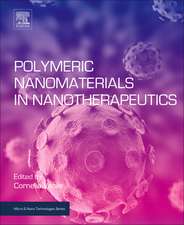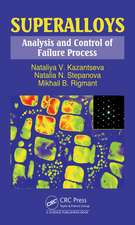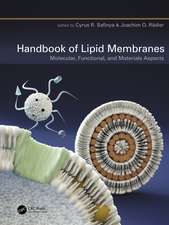An Introduction to Graphene and Carbon Nanotubes
Autor John E. Proctor, Daniel Melendrez Armada, Aravind Vijayaraghavanen Limba Engleză Hardback – 6 feb 2017
Suitable for undergraduate students with a working knowledge of basic quantum mechanics, and for postgraduate researchers commencing their studies into the field, this book will equip the reader to critically evaluate the physical properties and potential for applications of graphene and carbon nanotubes.
| Toate formatele și edițiile | Preț | Express |
|---|---|---|
| Paperback (1) | 443.11 lei 6-8 săpt. | |
| CRC Press – 30 iun 2020 | 443.11 lei 6-8 săpt. | |
| Hardback (1) | 680.80 lei 6-8 săpt. | |
| CRC Press – 6 feb 2017 | 680.80 lei 6-8 săpt. |
Preț: 680.80 lei
Preț vechi: 800.94 lei
-15% Nou
Puncte Express: 1021
Preț estimativ în valută:
130.27€ • 136.01$ • 107.82£
130.27€ • 136.01$ • 107.82£
Carte tipărită la comandă
Livrare economică 04-18 aprilie
Preluare comenzi: 021 569.72.76
Specificații
ISBN-13: 9781498751797
ISBN-10: 1498751792
Pagini: 302
Ilustrații: 120 Illustrations, black and white
Dimensiuni: 178 x 254 x 23 mm
Greutate: 0.75 kg
Ediția:1
Editura: CRC Press
Colecția CRC Press
Locul publicării:Boca Raton, United States
ISBN-10: 1498751792
Pagini: 302
Ilustrații: 120 Illustrations, black and white
Dimensiuni: 178 x 254 x 23 mm
Greutate: 0.75 kg
Ediția:1
Editura: CRC Press
Colecția CRC Press
Locul publicării:Boca Raton, United States
Public țintă
Postgraduate and UndergraduateCuprins
Introduction. Inter-atomic Bonding in Graphene and Diamond. Electronic Bandstructure of Graphene. Electronic Bandstructure of Carbon Nanotubes. Phonons in Graphene and Carbon Nanotubes. Raman Spectroscopy of Graphene and Carbon Nanotubes. Microscopy and Electron Diffraction Experiments on Graphene and Carbon Nanotubes. Synthesis of Graphene. Synthesis of Carbon Nanotubes. Mechanical and Thermal Properties of Graphene and Carbon Nanotubes. Chemical Modification of Graphene I: Hydrogenation and Halogenation. Chemical Modification of Graphene II: Graphene Oxide. Current Topics in Graphene and Carbon Nanotube Research. Appendix: Introduction to Raman Scattering Effect (in Crystalline Solids).
Notă biografică
John Proctor is a senior lecturer in physics at the University of Salford and is head of the Materials and Physics Research Group. He specialises in solid state physics, particularly the study of materials under extreme conditions. His works on graphene, silane and transition metal hydrides under high pressure have been highly cited. He regularly publishes research in leading international peer-reviewed journals, delivers contributed and invited talks at international conferences, and is a user at national and international synchrotron facilities. He was previously a lecturer at the University of Hull (2011 – 2013) and a post-doctoral research fellow at the University of Edinburgh (2007 – 2011). He obtained his PhD (2007) from the University of Manchester, and his MPhys (2004) from the University of Oxford.
Daniel Melendrez Armada is pursuing his PhD in nanomaterials at the University of Manchester. His research involves the development of graphene based sensors. He was awarded his MSc in Electrical Engineering with option in Bioelectronics (2012) from the Centre for Research and Advanced Studies of the National Polytechnic Institute, Mexico.
Aravind Vijayaraghavan is a lecturer in nanomaterials at The University of Manchester. He leads the Nano-functional Materials Group (www.nanofunc.com) and his research involves the science and technology of graphene and two-dimensional materials, particularly for applications in composites, electronics, sensors and biotechnology. He was previously a post-doctoral research fellow at Massachusetts Institute of Technology, USA and an Alexander von Humboldt Fellow at Karlsruhe Institute of Technology, Germany. He obtained his MEng (2002) and PhD (2006) from Rensselaer Polytechnic Institute, USA and his BTech (2000) from the Indian Institute of Technology - Madras, India. He has published over 60 papers in international peer reviewed journals and delivered over 50 presentations at international conferences. He is also a leader in public engagement and science communication and won the 2013 Joshua Phillips Award for Innovation in Science Engagement.
Daniel Melendrez Armada is pursuing his PhD in nanomaterials at the University of Manchester. His research involves the development of graphene based sensors. He was awarded his MSc in Electrical Engineering with option in Bioelectronics (2012) from the Centre for Research and Advanced Studies of the National Polytechnic Institute, Mexico.
Aravind Vijayaraghavan is a lecturer in nanomaterials at The University of Manchester. He leads the Nano-functional Materials Group (www.nanofunc.com) and his research involves the science and technology of graphene and two-dimensional materials, particularly for applications in composites, electronics, sensors and biotechnology. He was previously a post-doctoral research fellow at Massachusetts Institute of Technology, USA and an Alexander von Humboldt Fellow at Karlsruhe Institute of Technology, Germany. He obtained his MEng (2002) and PhD (2006) from Rensselaer Polytechnic Institute, USA and his BTech (2000) from the Indian Institute of Technology - Madras, India. He has published over 60 papers in international peer reviewed journals and delivered over 50 presentations at international conferences. He is also a leader in public engagement and science communication and won the 2013 Joshua Phillips Award for Innovation in Science Engagement.
Recenzii
'This book is a timely addition to the basic literature in this emerging field, given the recent huge surge in interest (and funding) the area. It is a text that graduate students starting out in graphene or carbon nanotubes should buy. The theoretical background and survey of important literature will provide an excellent grounding and reference for people entering the field.
The book is visually attractive with clear diagrams. The style is rigorous but approachable and the content assumes basic undergraduate physics. I found the book to be accessible to those with a chemistry background too. It is pitched at the right level for research students or final year undergraduates in the physical sciences. There are two main areas of content: (1) theoretical background; (2) preparation and applications of these materials. On the theoretical side, I found the coverage of metallicity in nanotubes particularly appealing. For a chemist, the synthesis sections are very interesting and well described. These would fit well into a course about carbon nanotubes. Similarly, the chapter on the functionalisation of graphene is appealing.
I enjoyed the rigorous but readable style. This text will complement many higher-level lecture courses and research projects.'
—Dr Timothy J Prior, Lecturer in Chemistry, University of Hull
"In this easy-to-follow textbook, the authors bring the exciting science of carbon nanostructures, from fullerenes to nanotubes and graphene, down to the level of senior undergraduate students. Having evolved from a University course on the same topic, this book builds up on basic understanding of physical phenomena, which science students typically acquire in the first two semesters, and a basic knowledge of quantum mechanics. Graphene turns out to be especially suitable for the introduction of concepts such as direct and reciprocal lattice, electronic and phonon band structure and density of states. The authors introduce the molecular orbital and tight-binding formalism as a basis to determine the electronic structure and provide a basic understanding of sp^1, sp^2 and sp^3 hybridization in different carbon allotropes. The reader is guided to develop an intuitive understanding of the role of p_pi electrons, which dominate the electronic response of graphitic nanostructures and that make graphene an unusual semi-metal, for what is special about the Dirac point and valleys in its band structure, the meaning of the chiral index and its role in the metallic or semiconducting nature of carbon nanotubes. Studying various aspects of graphene and nanotubes, the students gradually develop an appreciation for concepts underlying much of condensed matter physics and physical chemistry.
Since the authors are active researchers in the field, they provide useful insight into important topics including structural characterization by atomic-resolution transmission electron microscopy, X-ray as well as electron diffraction. They explain the effect of chemical modification of carbon allotropes and why studying the vibrational structure by Raman spectroscopy provides crucial information not only about particular nanostructures, but also about their quality. The readers learn about the advantages and disadvantages of methods to synthesize or exfoliate graphene and to synthesize nanotubes, including recent advances in synthesizing nanotubes with a specific chiral index. A chapter about recent developments, which rounds up this textbook, shows the reasons why this research field is still very active"
—David Tomanek, Michigan State University
The book is visually attractive with clear diagrams. The style is rigorous but approachable and the content assumes basic undergraduate physics. I found the book to be accessible to those with a chemistry background too. It is pitched at the right level for research students or final year undergraduates in the physical sciences. There are two main areas of content: (1) theoretical background; (2) preparation and applications of these materials. On the theoretical side, I found the coverage of metallicity in nanotubes particularly appealing. For a chemist, the synthesis sections are very interesting and well described. These would fit well into a course about carbon nanotubes. Similarly, the chapter on the functionalisation of graphene is appealing.
I enjoyed the rigorous but readable style. This text will complement many higher-level lecture courses and research projects.'
—Dr Timothy J Prior, Lecturer in Chemistry, University of Hull
"In this easy-to-follow textbook, the authors bring the exciting science of carbon nanostructures, from fullerenes to nanotubes and graphene, down to the level of senior undergraduate students. Having evolved from a University course on the same topic, this book builds up on basic understanding of physical phenomena, which science students typically acquire in the first two semesters, and a basic knowledge of quantum mechanics. Graphene turns out to be especially suitable for the introduction of concepts such as direct and reciprocal lattice, electronic and phonon band structure and density of states. The authors introduce the molecular orbital and tight-binding formalism as a basis to determine the electronic structure and provide a basic understanding of sp^1, sp^2 and sp^3 hybridization in different carbon allotropes. The reader is guided to develop an intuitive understanding of the role of p_pi electrons, which dominate the electronic response of graphitic nanostructures and that make graphene an unusual semi-metal, for what is special about the Dirac point and valleys in its band structure, the meaning of the chiral index and its role in the metallic or semiconducting nature of carbon nanotubes. Studying various aspects of graphene and nanotubes, the students gradually develop an appreciation for concepts underlying much of condensed matter physics and physical chemistry.
Since the authors are active researchers in the field, they provide useful insight into important topics including structural characterization by atomic-resolution transmission electron microscopy, X-ray as well as electron diffraction. They explain the effect of chemical modification of carbon allotropes and why studying the vibrational structure by Raman spectroscopy provides crucial information not only about particular nanostructures, but also about their quality. The readers learn about the advantages and disadvantages of methods to synthesize or exfoliate graphene and to synthesize nanotubes, including recent advances in synthesizing nanotubes with a specific chiral index. A chapter about recent developments, which rounds up this textbook, shows the reasons why this research field is still very active"
—David Tomanek, Michigan State University
Descriere
Carbon nanotubes and graphene have been the subject of intense scientific research since their relatively recent discoveries. This book introduces the reader to the science behind these rapidly developing fields, and covers both the fundamentals and latest advances. Uniquely, this book covers the topics in a pedagogical manner suitable for undergraduate students. The book also uses the simple systems of nanotubes and graphene as models to teach concepts such as molecular orbital theory, tight binding theory and the Laue treatment of diffraction.
Suitable for undergraduate students with a working knowledge of basic quantum mechanics, and for postgraduate researchers commencing their studies into the field, this book will equip the reader to critically evaluate the physical properties and potential for applications of graphene and carbon nanotubes.
Suitable for undergraduate students with a working knowledge of basic quantum mechanics, and for postgraduate researchers commencing their studies into the field, this book will equip the reader to critically evaluate the physical properties and potential for applications of graphene and carbon nanotubes.
























